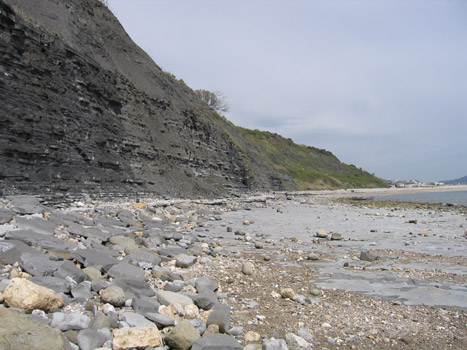Biggest Land Slip for 99 Years at Charmouth
Huge Landslide on the Jurassic Coast
At around 10.30pm on Tuesday night (6th May), a 400 metre section of the coastline between Lyme Regis and Charmouth on the English Jurassic coast collapsed. The section of cliff, approximately the length of four football pitches slipped at high tide, this is very fortunate as nobody was on the beach at the time.
Team members of Everything Dinosaur had been in that very spot just 24-hours before, scouring the beach picking up pyritised Promicroceras ammonites and fossilised belemnite guards (the landslide was not our fault – honest)! We had noticed how saturated the cliffs were, both to the east of Lyme Regis and at Monmouth beach, which we had visited the day before. There were streams of water pouring out from the cliff face and signs of recent rock falls.
Despite the obvious dangers we observed a number of tourists, looking for fossils very close to the cliffs and even climbing over some of the mudflows on the Charmouth side of the beach. This is very dangerous, Tuesday’s landslide is testament to this. The best place to find fossils is on the beach itself. The soft mud and clay gets washed out from the cliffs and deposits fossils along the shoreline. It is best to keep away from the cliffs, after Tuesday’s landslip there were reports of boulders the size of cars tumbling down onto the beach.
A View of the Dangerous Cliffs at Lyme Regis

Picture credit: Everything Dinosaur
Monmouth Beach
The picture shows a view of Monmouth beach looking back towards Lyme Regis. This beach lies to the west of Lyme Regis, the actual land slip occurred to the east of the town, between Lyme Regis and the village of Charmouth.
Fossil hunters and amateur palaeontologists are going to have to be patient before they can get access to any fossils that may have been exposed as a result of the landslip. The local authorities are working hard to assess the condition of the site and whether more landslides are likely to occur. A number of people have ignored the warnings about the dangers and ventured onto the beach in search of specimens.
Lyme Regis Rubbish Dump
Unfortunately, the landslip has exposed an old rubbish dump and debris such as old bottles, car batteries and radiators now litter the beach. Coincidentally, we were chatting to one of the Charmouth Heritage centre staff and they were commentating how dirty the Charmouth beaches were becoming. A few weeks ago a number of the Charmouth Heritage centre staff were involved in a voluntary rubbish collection event, they team filled 56 bags with rubbish, much of which had been left by careless tourists, but some would have come from the recently grounded ship – the Napoli, which floundered off Lyme Bay.
Commenting on the land slip Graham Turner, the station manager for Lyme Regis coastguard, said:
“The dump has been closed for 25 years and was 300ft inland. The landslide has taken the cliff edge back to the start of it and the place is strewn with litter. There are thousands of bottles, broken glass, plastic, tyres and even immersion heaters lying among the mud. When it was in use, the dustmen did not have carts to compact the rubbish and it was thrown into the ground raw. We don’t think it will get washed away by the tide but at the moment we have no idea how we are going to get rid of it.”
Some of the Rubbish on Charmouth Beach
Picture credit: Times Online
Local police and coastguard officials are urging members of the public to keep off the beach as the area is still not safe, but this will not stop many hardy fossil hunters looking for the discovery of a lifetime.
Landslips are common in this area, as the cliffs are very unstable, and although a lot of investment has been carried out to reduce the damage in and around Lyme Regis itself funding is still being sort from DEVRA to help stabilise the land to the east of the town.
Sally Holman, the Mayor of the town, said that the landslip was a warning that funding had to be found for the next stage of the coastal stabilisation programme – estimated to cost at least £21 million. “It was very lucky this happened at high tide so that no one was on the beach,” she stated. “What it shows is how urgently the next phase of the protection scheme needs to be carried out.”
The landslip has actually just missed the best fossil beds on that part of the Jurassic coast, although there will no doubt be a large number of new fossils deposited onto the beach as a result of this event. Such land slides are a natural process and eventually the whole of the Lyme Regis area will be washed away. This process is constantly exposing new specimens for the enthusiastic fossil hunters to find.
A Close up of the Cliffs on Monmouth Beach

Picture credit: Everything Dinosaur
The picture shows part of the cliffs on Monmouth beach to the west of Lyme Regis, debris from a recent rockfall can clearly be seen.
Our team members will get to hear of any interesting finds amongst the broken bottles and car tyres, we will be able to report them on the web log.
For models and replicas of ammonites, ichthyosaurs and belemnites: CollectA Prehistoric Life Models and Replicas.


